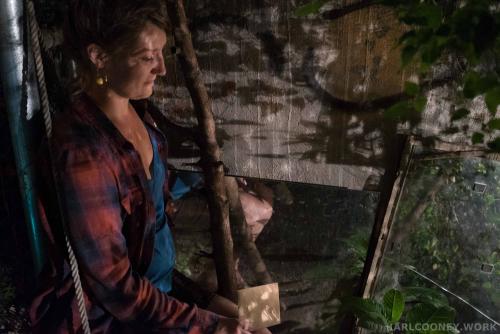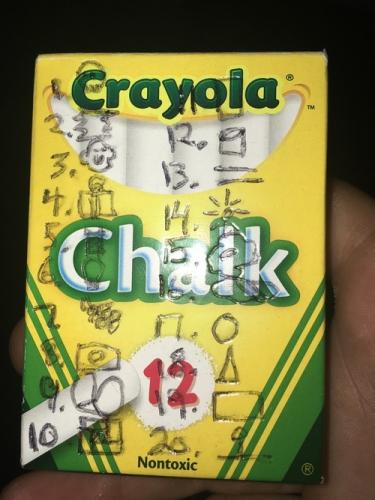YOU DON’T HAVE TO LOOK AT THIS (augury 1)
1.) Karl Cooney invites PPL to “apply” for a series in which he plans to stage performance art works at Le Petit Versaille for the express purpose of documenting/archiving them (and production of documentation as “his own work”). PPL proposes a mini-play about plants, which is accepted.
2.) PPL situate three processes at Le Petit Versaille on Friday night, July 28:
PROCESS “A:” Kaia Gilje inscribes a series of 20 “contingencies” into the situation by inviting those present to perform actions (see score below) based on read/attended/interpreted occurrences/signs.
PROCESS “B:” Brian McCorkle takes one person at a time for an interview, conducted while walking pre-deliberated pathways around the site on the LES. Each interview generates an auspicious symbol, which is drawn in chalk as a temporary sign for near- future passers-by.
PROCESS “C:” Esther Neff asks 11 people to write problems or decisions that they need a “sign” about on cards, to seal these cards inside gold envelopes, and to pose for Karl Cooney with the card-in-envelope somewhere in the garden. Participants are then told that these images will function as “auguries,” providing the “sign” requested, and given the URL of this page.
3.) Karl Cooney provides PPL with the 11 (watermarked) photographs generated via process “C.” PPL provides an interpretive key (augury) enable the 11 participants in process “C” to interpret any significance in/to these images and publishes the scores and documentation from this performance on the page you are now viewing.
PROCESS “C” IMAGES
1.)

2.)

3.)

4.)

5.)

6.)

7.)

8.)

9.)

10.)

11.)

PROCESS “C” AUGURY NOTES & EXAMPLE INTERPRETATIONS
The way in which the subject is holding the card may be seen to signify their emotional attitude towards what they wrote on the card (look for chakric placement, distance from the body, treatment of the envelope)…
The subject’s directional gaze signifies their dominant way of approaching/interacting with/becoming “the world…”
Objects present in the frame may have symbolic interpretations….
Relationship between photographer (Karl) and subject may signify relationships with “others” in general, and/or may seen to signal comfort or discomfort with Karl in particular, and/or seen to reveal the subject’s relationship with their own image
Example readings…
1: the subject seems to be offering a gift but also asking for one, they are insecurely attached, perhaps looking for love, leaving space on the righthand side of the frame for someone to take on their problem/decision
2: the subject is muted/silenced by their problem or decision, hands are full, subject is overwhelmed and seeking balance
3: subject is centered and holding the card out in front of themselves, the subject is confident that this problem or decision will be solved by “society” or by others, and/or has already decided/solved this problem for themselves
4: subject grips the envelope hard with two fingers: subject is posturing confidence/control and attempting to wear this problem or decision as a badge of honor, subject is also located in the center of the garden in full light, aggressively signaling dominance
5: subject is visually connecting their crown chakra and problem/decision to a disco ball, perhaps attempting to solve a spiritual/ethical disconnect using aesthetics
6: subject holds the envelope near to their heart and looks directly into the world; the blurriness of the background (no recognizable objects) foregrounds this subject as a catalyst and healer for problems and decisions at large
7: subject obscures their face with the problem or decision, literally wearing it as a mask or hiding behind it. The slightly blurry wild roses in the background are bespoke of paradoxes, the impossibility of being “good” in a “bad” world
8: only the tip of the envelope is visible: subject has banished this decision or problem or is attempting to repress or exclude it from their life. The roses are in sharp focus, signifying bridges between life and death, consciousness and dreams
9: the envelope is lit but partially obscured by ivy. The subject is not present in the image, having objectified the problem or decision, perhaps in hopes of seeing it more clearly; subject is perhaps disconnected from their own needs and emotions
10: subject places the envelope gently on an empty chair; problem or decision may involve grief or leaving something/someone behind. The subject is shot from over the shoulder, face lit but in less-than- half-profile, obscurant foreshortening is also present
11: quite a bit of diffraction and optical illusion is present: mirrors (signifying representation, memory, self-recognition) and the dappling of the light may signify self-delusion and/or confusion with forms of subjecthood
SIGNS FROM PROCESS “B”

SCORE FOR PROCESS “A”
1. When you notice someone has left the garden, or if you notice another person sigh, yawn, or display some sign of exhaustion-
take this blanket and find a quiet place to lay down on it.
2. If you feel at any point overwhelmed, or if you notice someone else eating-
find a hidden location to watch others from
3. If you notice someone jumping up and down-
starting at one entrance of the garden, walk as slowly as possible through the garden until you arrive at the opposite entrance.
4. When you notice the person Brian has taken with them return to the garden-
find one particular leaf that you particularly like and then find someone to describe it to.
5. If you see someone laying down-
enter a conversation that you are not a part of and make a series of facial expressions.
6. If you notice someone walking through the garden very slowly-
join them.
7. If you hear an especially loud or abrupt noise-
Find something that you are attracted to, and attract other’s attention to it.
8. If you think it may rain soon, or if you hear or see someone raise an alarm-
stand on the wooden stage by the microphone stand and wiggle your fingers, wait for someone to stand across from you and then follow their lead.
9. Count how many people are in the garden and immediate vicinity-
then enter and exit the garden that number of times, each time with a different greeting.
10. If you notice someone shrug or if you see someone enter and exit repeatedly-
go and put your hands or feet in the dirt.
11. If you notice a particularly quiet or still moment-
Find an object to apply pressure to, or ask another person to apply pressure to you.
12. If you notice a something that could fall over-
make a series of large gestures nearby
13. If you feel a tense moment, or notice anyone applying pressure to anyone else-
find the compost and smell it.
14. If you notice a person making a series of facial expressions-
Find a tool and use it in a way it was not designed to be used
15. If you notice a conversation ending-
Find a perfect place for yourself in the garden and relax.
16. If you notice someone walking very slowly-
Find someone to go up to and make a series of small gestures with your hands
17. If you see anyone laughing-
jump three times
18. If you see someone using a tool in a way that you do not think it was designed to be used-
Seek a moment of intimacy with a non- human being.
19. If you see a person standing on the wooden stage next to the microphone stand wiggling their fingers-
stand opposite of them on the wooden stage. Maintain eye contact with them and walk the perimeter of the state for one rotation.
20.
If you see someone laying down-
laugh.
